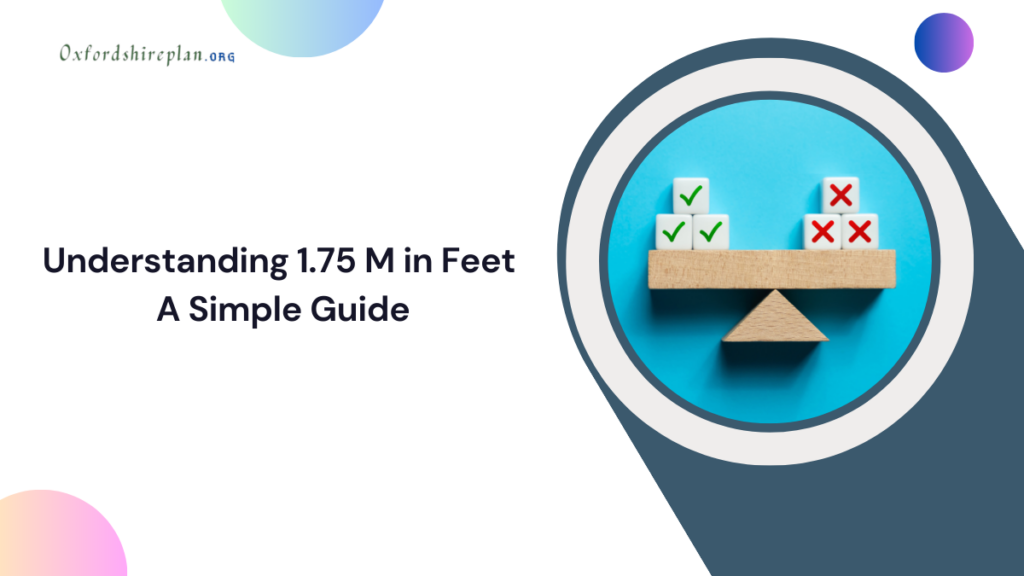Have you ever wondered how tall 1.75 meters in feet is? While many countries use meters to measure height, converting it to feet and inches makes it easier for those familiar with the imperial system. In this guide, we’ll break it down step by step, helping you understand the conversion and giving real-world context to visualize what 1.75 m in feet looks like.\

Contents
What is a Meter?
Before we jump into the conversion, let’s briefly explain what a meter is:
- A meter is part of the metric system and is a standard unit of length.
- It is officially defined by the distance light travels in a vacuum in 1/299,792,458 of a second! While this may sound scientific, what’s important to know is that a meter is a precise and universal measurement.
What is a Foot?
Now let’s look at the foot, a unit of length in the imperial system:
- One foot equals 12 inches.
- Today, 1 foot is officially defined as 0.3048 meters, which helps in converting between meters and feet. This conversion makes it easier to understand how 1.75 meters in feet translates.
Converting 1.75 Meters to Feet
Now, let’s break down how to convert 1.75 meters in feet:
- To convert meters to feet, multiply the meter value by 3.28084 (the conversion factor).Calculation:1.75 meters×3.28084 feet/meter=5.74 feet1.75 \, \text{meters} \times 3.28084 \, \text{feet/meter} = 5.74 \, \text{feet}1.75meters×3.28084feet/meter=5.74feet
- So, 1.75 meters is approximately 5 feet 9 inches.
Visualizing 1.75 Meters in Feet
Here’s how you can visualize 1.75 m in feet in different contexts:
| Context | Height in Feet & Inches | What It Means |
|---|---|---|
| Average Male Height | 5’9″ | Considered an average height for men in many regions |
| Sports Reference | 5’9″ | Shorter than the average NBA player, but a common height |
| Door Frame Comparison | Slightly shorter than a 7′ door (2.13 meters) | A person this height would be noticeably shorter than a standard doorframe |
1.75 Meters in Different Everyday Contexts
Let’s explore some real-life situations where knowing 1.75 meters in feet can come in handy:
Height Comparisons
- For Men: At 5 feet 9 inches, this is an average height for men in many countries like the UK and parts of Europe and Asia.
- For Women: In many regions, 1.75 meters in feet would be considered tall for women.
Sports Comparisons
- Basketball: The basketball hoop stands at 10 feet, so someone who is 1.75 meters in feet tall would need to jump quite a bit to reach the rim.
- Tennis: A tennis net stands at about 3 feet, so a person this height would be towering over it.
Everyday Objects
- Chairs and Tables: Dining room chairs are typically about 1 meter tall, so someone at 1.75 meters in feet would be about the height of one-and-three-quarters of a chair.
- Small Trees: Many young garden trees grow to about 1.75 meters in feet, making this height comparable to a small tree.
Conversion Tips: Quick and Accurate
When converting 1.75 meters to feet, here are two approaches:
- Exact Conversion: For precision, use the exact conversion factor—1 meter = 3.28084 feet.
- Quick Estimate: For a rough estimate, remember that 1 meter ≈ 3.3 feet, so 1.75 meters in feet is roughly 5.8 feet.
Additional Considerations for 1.75 Meters
- Cultural Perceptions: Whether 1.75 m in feet is considered tall or average depends on the region. In some places, this height might be seen as tall, while in others it’s closer to average.
- Personal Variations: Even among people who are the same height, proportions, and body shapes can make them appear quite different.
Conclusion
Converting 1.75 meters in feet isn’t just a simple math exercise—it helps provide real-world context. At 5 feet 9 inches, 1.75 meters is a height many people across the world are familiar with, whether it’s athletes, everyday individuals, or even objects around you.
By understanding how 1.75 m in feet translates, you’ll be able to better visualize height in both the metric and imperial systems, and gain a clearer understanding of how it applies to different situations, from sports to everyday life

I am a dedicated lifestyle and fashion enthusiast, always looking for the latest trends and timeless styles. With a flair for creativity and a passion for self-expression, I provide fresh insights and tips on elevating everyday living and personal style.
















